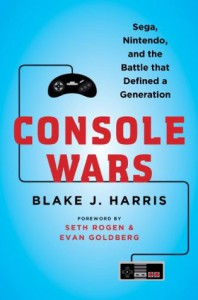Console Wars: Sega, Nintendo, and the Battle that Defined a Generation
 When the folks at Nintendo released the 8-bit NES (Nintendo Entertainment System), the home console industry was on its last legs. Following a spectacular crash of the gaming market in 1983 (Atari’s E.T. fiasco), Nintendo had its work cut out for it if it believed it could take the medium off of life support. By limiting supply, taking a hard stance on game quality and working with some of the largest retailers in North America, the Japanese company single-handedly resurrected the industry and put gaming back into the popular culture.
When the folks at Nintendo released the 8-bit NES (Nintendo Entertainment System), the home console industry was on its last legs. Following a spectacular crash of the gaming market in 1983 (Atari’s E.T. fiasco), Nintendo had its work cut out for it if it believed it could take the medium off of life support. By limiting supply, taking a hard stance on game quality and working with some of the largest retailers in North America, the Japanese company single-handedly resurrected the industry and put gaming back into the popular culture.While Nintendo was enjoying record profits and unparalleled success, a competitor was sitting on the sidelines, struggling to find a way to get into the game. Sega had released their own 8-bit console dubbed The Master System and while they sold a respectable number of units, they were nothing more than a blip on Nintendo’s radar. With their new 16-bit (double the power of the NES) next generation console, the Sega Genesis, they needed a true visionary to lead the company into battle.
Enter Tom Kalinske. While he’s not a name you may know at first glance, his work with toy giants Mattel and Matchbox could be considered legendary. Armed with a team of marketing mavens, Kalinske would revolutionize the gaming industry and take it to Nintendo like no one had before.

Being born in 1984, I was the target market for both Sega and Nintendo. However, I was lucky enough to own both consoles. Having lived through their fiercely competitive battle, I thought I knew a great deal about each company’s drive to control the gaming market. Turns out, I was wrong. I learned so much from this book and Harris’ choice to present this in a narrative style kept the pages turning and made putting the book down nearly impossible.
Tom Kalinske’s dream team of marketing experts did so much to revolutionize the industry. They beat Nintendo to the 16-bit market, they organized the first ever global video game launch with Sonic 2sday (the first “street date” established for a video game with their sequel to the mega-successful Sonic The Hedgehog) and even went so far as to blatantly attack their competition with their commercials and the "Welcome to the Next Level" campaign.
As with any business, competition forces creativity. Nintendo had a virtual stranglehold on console gaming and without Sega’s constant drive to be better, Nintendo may not have explored the true power of the SNES (Super Nintendo Entertainment System). Games like Mario Kart, Star Fox and the groundbreaking Donkey Kong Country may never have been made if Sega had not forced Nintendo’s hand.
While Sega was never able to reach the dizzying heights they had with subsequent consoles (the Sega Saturn or the Sega Dreamcast), their hard work and brilliant ideas can still be felt throughout the industry today. Their signature character Sonic the Hedgehog continues to appear in countless games developed for the three leading video game companies - one of which being Nintendo itself!
I could go on and on about just how fantastic this book is but I’ll let the subject matter speak for itself. While I haven’t read [b:The Accidental Billionaires: The Founding of Facebook, a Tale of Sex, Money, Genius and Betrayal|6326920|The Accidental Billionaires The Founding of Facebook, a Tale of Sex, Money, Genius and Betrayal|Ben Mezrich|https://d.gr-assets.com/books/1320527444s/6326920.jpg|6512514] or [b:Moneyball: The Art of Winning an Unfair Game|1301|Moneyball The Art of Winning an Unfair Game|Michael Lewis|https://d.gr-assets.com/books/1388176510s/1301.jpg|416305], it’s been said that if you were a fan of those releases, you should pick this one up next.
**Console Wars is currently being developed for a feature length film release as well as a documentary.
Cross posted @ Every Read Thing
Check out my interview with Blake!




